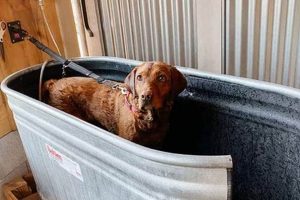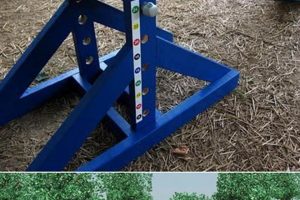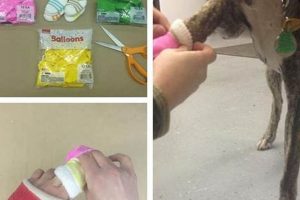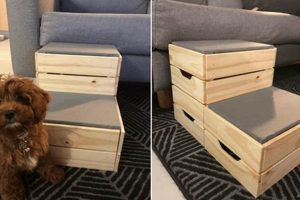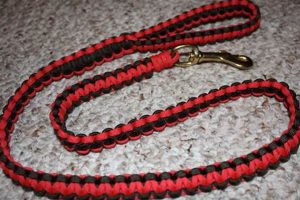Constructing a barrier at home to contain a canine companion involves utilizing materials and methods readily accessible to the average homeowner. This approach allows for customized solutions tailored to specific yard sizes, dog breeds, and aesthetic preferences, often resulting in a cost-effective alternative to professional installation services. For instance, a homeowner might choose to assemble a wire mesh structure supported by wooden posts, adapting the height and strength to suit the dog’s size and propensity to escape.
The practice provides several advantages, including increased control over the perimeter, the potential for significant cost savings compared to professional installations, and the opportunity for personalization. Historically, homeowners have employed various materials, ranging from repurposed wood to locally sourced stone, to create boundaries for their pets. This approach fosters self-reliance and allows for a barrier that integrates seamlessly with the existing landscape, enhancing property value and pet safety.
The subsequent discussion will delve into the various types of materials suitable for these projects, the essential tools required for successful implementation, step-by-step instructions for common construction methods, and considerations for ensuring the structure’s effectiveness and longevity in safeguarding the pet’s well-being.
Practical Guidance for Perimeter Construction
Effective perimeter construction for canine containment relies on careful planning and execution. Adherence to the following guidelines enhances the structure’s durability and efficacy.
Tip 1: Material Selection is Crucial. Choose materials appropriate for the dog’s size and temperament. A small dog might be adequately contained by lightweight mesh, whereas a larger, more determined dog requires heavier gauge wire or solid panels.
Tip 2: Precise Measurement Prevents Errors. Accurately measure the perimeter to be enclosed before purchasing materials. This minimizes waste and ensures sufficient material for the entire project.
Tip 3: Post Depth Ensures Stability. Bury posts deep enough to prevent tipping or leaning. As a general rule, bury at least one-third of the post’s length below ground level. Concrete reinforcement may be necessary in unstable soil.
Tip 4: Tensioning Wire Improves Security. If using wire mesh, properly tension the wire to prevent sagging and potential escape routes. Utilize tensioning devices or stretching tools to achieve uniform tautness.
Tip 5: Consistent Height Deters Jumping. Maintain a consistent height around the entire perimeter to discourage jumping. Varying heights create vulnerable points that a dog may exploit.
Tip 6: Regular Inspection Identifies Weaknesses. Routinely inspect the structure for signs of damage or wear. Promptly repair any breaches or weaknesses to maintain its integrity.
Tip 7: Consider the Landscape. Account for uneven terrain or existing landscaping features. Adjust the structure’s design to accommodate these elements, ensuring a seamless and secure enclosure.
Implementing these guidelines will contribute to a secure and lasting barrier, promoting the safety and well-being of the canine companion.
The following sections will explore common pitfalls and solutions to ensure long-term containment success.
1. Material Durability
The longevity and effectiveness of a self-constructed canine enclosure are directly predicated on the durability of the chosen materials. Inferior materials, susceptible to weathering, impact damage, or degradation from canine interaction, compromise the barrier’s integrity, leading to potential breaches and jeopardizing the pet’s safety. For instance, untreated wood used in a structure’s frame may rot over time, weakening the support and allowing a dog to escape. Similarly, lightweight wire mesh can be easily torn or bent by a larger, more determined breed, rendering it ineffective as a containment solution. The initial cost savings associated with less durable materials are often offset by the expenses of frequent repairs or complete reconstruction. Therefore, material selection is not merely an aesthetic consideration but a fundamental determinant of the fence’s long-term functionality.
The practical implications of prioritizing material durability are significant. When constructing a barrier, pressure-treated lumber, galvanized steel, or composite materials offer superior resistance to environmental degradation and physical stress. These materials, while potentially more expensive initially, extend the lifespan of the enclosure, reducing the need for ongoing maintenance and replacement. Furthermore, the choice of fasteners and hardware directly impacts the structure’s robustness. Corrosion-resistant screws and hinges prevent weakening at critical connection points. Consider the example of a homeowner in a coastal environment using standard steel hardware; the salt air would rapidly corrode these components, compromising the fence’s stability and potentially creating hazardous conditions for the animal. Employing stainless steel hardware in such an environment mitigates this risk, ensuring a secure and durable enclosure.
In conclusion, the correlation between material durability and the overall success of self-constructed canine enclosures is undeniable. Neglecting this aspect can lead to premature failure, increased maintenance costs, and, most importantly, a compromised safety environment for the pet. While the initial investment may be higher, prioritizing durable materials ultimately translates to a more secure, reliable, and cost-effective containment solution over the long term. The responsible homeowner must carefully assess the environmental conditions, the dog’s behavior, and the available material options to ensure a construction that withstands the test of time and maintains its intended purpose.
2. Height Sufficiency
Height sufficiency is a critical determinant of success in any self-constructed canine barrier. The underlying principle rests on the dog’s inherent ability to overcome physical obstacles. An inadequate height provides a direct route of escape, negating the purpose of the enclosure. Cause and effect are directly linked: insufficient height causes escapes, while sufficient height deters them. Its importance stems from it being a primary physical barrier. A fence built to a height of two feet will be ineffective for a dog capable of jumping three feet. Consequently, careful consideration of the dog’s breed, age, athleticism, and motivation to escape is crucial during the planning phase.
Practical application necessitates accurate measurement and an understanding of canine jumping capabilities. Border collies, known for their agility, may require a taller barrier than a less athletic breed of similar size. Furthermore, elements within the enclosure, such as sheds or landscaping features, can inadvertently provide a launch point, effectively reducing the barrier’s functional height. The construction must therefore account for the entire environment, eliminating potential advantages for the canine. For instance, a homeowner who neglects to remove a pile of firewood adjacent to a four-foot fence might find that their Labrador retriever can easily clear the barrier using the firewood as a stepping stone.
In summary, ensuring height sufficiency is a fundamental requirement when undertaking a self-constructed canine barrier project. Insufficient height renders the entire effort futile. Accurate assessment of the dog’s capabilities and a thorough understanding of the surrounding environment are essential for creating a secure and effective enclosure. While other aspects of the structure, such as material strength and post stability, are also important, height represents the first line of defense against escape and demands meticulous attention to detail. The homeowner must consider these elements to maximize the long-term containment benefits and promote responsible pet ownership.
3. Post Stability
Post stability represents a crucial structural element within self-constructed canine enclosures. Its significance arises from the direct correlation between stable posts and the overall integrity of the perimeter. Insufficiently secured posts compromise the structure’s ability to withstand external forces, such as wind, animal impact, or ground movement, leading to potential collapse or breaches. The cause is inadequate anchoring, and the effect is a compromised containment system. Real-world examples abound: a light fence constructed with shallowly buried posts is easily uprooted by a strong gust of wind, creating an escape route. Conversely, a well-constructed barrier with deeply set, concreted posts maintains its structural integrity even under duress.
Practical application involves adhering to established construction principles. Post depth should typically constitute at least one-third of the above-ground height, and the use of concrete backfill provides enhanced stability, especially in loose or unstable soil. The diameter of the post also contributes to stability, with larger diameters offering greater resistance to bending or breakage. Furthermore, the spacing between posts influences the overall rigidity of the structure; closer spacing reduces the span between supports, minimizing the potential for sagging or buckling. Consider a homeowner building a six-foot-high structure; neglecting to use appropriately sized posts set in concrete would likely result in a leaning, unstable barrier susceptible to failure under even moderate stress.
In conclusion, post stability is not merely an optional consideration, but a fundamental requirement for a successful self-constructed canine enclosure. Neglecting this aspect undermines the entire effort, creating a weak and unreliable barrier. Proper post selection, installation depth, and reinforcement techniques are essential for ensuring long-term structural integrity and maintaining a secure environment for the pet. The consequences of inadequate post stability are far-reaching, potentially jeopardizing the animal’s safety and negating the purpose of the containment system.
4. Secure gates
The inclusion of secure gates is a non-negotiable element within the realm of self-constructed canine enclosures. The absence of properly functioning gates directly negates the effectiveness of the surrounding barrier. A lapse in gate security provides an obvious and easily exploitable breach point, rendering the remaining structure practically irrelevant. The relationship is causal: a gate that is not secure allows escape, irrespective of the surrounding structure’s robustness. Consider a scenario where a homeowner meticulously constructs a perimeter with durable materials and properly braced posts, only to install a gate with a flimsy latch that a dog can easily manipulate. The entire effort is undermined by this single point of failure.
Practical implementation requires careful attention to detail at all stages, from material selection to installation. The gate itself should be constructed of materials comparable in strength and durability to the primary fence. Hinges must be robust and properly aligned to prevent sagging or binding, which can compromise the latching mechanism. Latches should be designed with canine behavior in mind, resisting manipulation through paws, noses, or body weight. Examples of effective gate security include the use of double latches, spring-loaded mechanisms, or even padlock-compatible closures, particularly for breeds known for their problem-solving abilities. The gate frame must also be securely anchored to the supporting posts, preventing gaps or weaknesses that a dog could exploit to squeeze through. Furthermore, the ground beneath the gate should be addressed to prevent digging escapes; options include burying wire mesh or concrete footings to create a physical barrier.
In summary, the design and execution of secure gates are as crucial as the construction of the surrounding barrier when creating a self-constructed canine enclosure. A seemingly minor oversight in gate security can negate the entire project, rendering the containment system ineffective. Responsible pet ownership dictates that homeowners prioritize gate security, ensuring a complete and reliable perimeter that effectively safeguards their canine companions. Overlooking this aspect invites potential escapes and undermines the very purpose of the enclosure.
5. Ground anchoring
Ground anchoring is a critical, often overlooked, component of self-constructed canine enclosures. Its implementation directly addresses a common escape tactic employed by many dogs: digging. Without adequate ground anchoring, even a structurally sound barrier can be circumvented, rendering the entire enclosure ineffective. Therefore, understanding the principles and methods of ground anchoring is essential for successful pet containment.
- Preventing Digging Escapes
The primary role of ground anchoring is to physically prevent a dog from digging underneath the structure. This is achieved by extending the barrier below the surface of the ground, creating a subsurface obstacle that the dog cannot easily bypass. Examples include burying wire mesh or chain-link fencing along the base of the perimeter, creating an underground “skirt” that deters digging. The implications are clear: failing to implement this measure leaves the enclosure vulnerable to persistent digging attempts.
- Material Selection for Subsurface Barriers
The choice of materials for ground anchoring impacts its effectiveness and longevity. Materials must be resistant to corrosion and degradation from soil moisture and contact. Galvanized wire mesh is a common choice, providing a durable and cost-effective solution. Concrete footings can also be used to create a solid, impenetrable barrier along the base. The implications of selecting inappropriate materials include premature failure of the ground anchoring system, requiring costly repairs and increasing the risk of escapes.
- Installation Techniques for Effective Anchoring
Proper installation is crucial for ensuring the effectiveness of ground anchoring. The subsurface barrier must be buried deep enough to deter digging, typically at least 12 inches below the surface. The width of the buried barrier is also important, extending outward from the fence line to create a wider zone of deterrence. Securely attaching the subsurface barrier to the above-ground portion of the fence is essential to prevent it from being pulled up or dislodged. Failing to adhere to proper installation techniques can result in a compromised ground anchoring system that is easily defeated by a determined dog.
- Integration with Landscape and Soil Conditions
The design and implementation of ground anchoring should consider the existing landscape and soil conditions. Rocky or compacted soil may require specialized tools or techniques for installation. Uneven terrain may necessitate adjustments to the depth and configuration of the subsurface barrier. In areas with poor drainage, it may be necessary to install drainage systems to prevent water accumulation around the base of the structure. Ignoring these factors can lead to a poorly integrated ground anchoring system that is prone to failure.
In conclusion, the effectiveness of a self-constructed canine enclosure hinges on the implementation of a well-designed and properly installed ground anchoring system. By addressing the common digging behavior of dogs, ground anchoring provides a critical layer of security that prevents escapes and ensures the safety and well-being of the pet. Neglecting this aspect leaves the enclosure vulnerable, regardless of the strength and height of the above-ground barrier.
6. Perimeter Integrity
Perimeter integrity, in the context of self-constructed canine enclosures, represents the holistic soundness and inviolability of the barrier. It directly correlates with the ability of the structure to effectively contain the dog, preventing escapes and ensuring its safety. Compromises in perimeter integrity render the entire structure ineffective, regardless of individual component strengths.
- Consistent Structural Soundness
A primary facet of perimeter integrity is the consistent quality and stability of all structural elements. This encompasses not only the fence panels or mesh but also the posts, gates, and any subsurface barriers. For instance, a perimeter with sections of weakened or corroded wire mesh presents a point of vulnerability, even if the remaining sections are robust. Similarly, gaps or openings, regardless of their size, compromise the overall containment capability. These weaknesses can be exploited by a determined dog, defeating the purpose of the enclosure. Regular inspection and prompt repair are crucial for maintaining consistent structural soundness.
- Seamless Interconnection of Components
The effectiveness of a perimeter depends not only on the individual components but also on the quality of their interconnection. Weaknesses at connection points, such as improperly attached fence panels or poorly aligned gate hinges, create vulnerabilities that can be exploited. For example, a gate hinge that is not securely fastened to the post can allow the gate to sag, creating a gap that a small dog can squeeze through. Furthermore, the transition between the above-ground barrier and any subsurface components must be seamless, preventing digging escapes. Proper installation techniques and the use of appropriate hardware are essential for achieving seamless interconnection.
- Resistance to Environmental Factors
Perimeter integrity is also influenced by the ability of the structure to withstand environmental factors such as wind, rain, and temperature fluctuations. Materials that are susceptible to corrosion, rot, or UV degradation compromise the long-term integrity of the barrier. For instance, untreated wood posts can rot over time, weakening the structure and creating a potential escape route. Similarly, wire mesh that is not properly galvanized can corrode, leading to breaks and gaps. Selecting materials that are appropriate for the local climate and implementing protective measures, such as painting or sealing, are essential for maintaining perimeter integrity over time.
- Adaptation to Canine Behavior
Ultimately, perimeter integrity is defined by its ability to effectively contain the specific dog for which it is intended. Factors such as the dog’s size, breed, temperament, and motivation to escape must be considered. A perimeter that is adequate for a small, docile dog may be insufficient for a larger, more athletic breed with a strong desire to roam. Therefore, the design and construction of the enclosure must be tailored to the individual dog’s characteristics. This may involve increasing the height of the barrier, reinforcing weak points, or implementing additional security measures, such as deterrents or monitoring systems. Ongoing observation of the dog’s behavior is essential for identifying and addressing any potential vulnerabilities in the perimeter.
In summary, perimeter integrity is a multifaceted concept that encompasses structural soundness, seamless interconnection, environmental resistance, and adaptation to canine behavior. Maintaining a high level of perimeter integrity is crucial for ensuring the effectiveness of self-constructed canine enclosures and promoting the safety and well-being of the pet. Careful planning, proper construction techniques, and ongoing maintenance are essential for achieving this goal. A compromise in any of these areas can undermine the entire effort, leaving the enclosure vulnerable to breaches and putting the dog at risk.
7. Dog's Behavior
Canine behavior is inextricably linked to the success or failure of self-constructed canine enclosures. A fundamental understanding of a dog’s specific tendencies, motivations, and physical capabilities is essential for designing and building an effective barrier. The cause-and-effect relationship is direct: specific behavioral traits dictate the necessary features of the enclosure. For example, a dog prone to digging requires ground anchoring, while one with a high prey drive and propensity for jumping necessitates a taller, more robust structure. Ignoring these behavioral cues leads to a compromised enclosure and potential escape.
The practical implications of incorporating behavioral knowledge into enclosure design are significant. Consider a Jack Russell Terrier, a breed known for its digging prowess and determination. A standard fence, even one of adequate height, is unlikely to contain such a dog without the implementation of subsurface barriers and reinforced corners. Conversely, a less athletic breed with minimal digging tendencies might be adequately contained by a simpler, less elaborate design. Behavioral observation should inform every stage of the project, from material selection to overall dimensions. Furthermore, ongoing monitoring of the dog’s interaction with the enclosure is crucial for identifying and addressing any emerging vulnerabilities. This adaptive approach ensures the enclosure remains effective over time, even as the dog’s behavior evolves.
In conclusion, dog behavior is not merely a peripheral consideration but a central component of successful self-constructed canine enclosures. A comprehensive understanding of a dog’s individual traits is essential for creating a barrier that effectively addresses its specific needs and tendencies. Ignoring this critical factor increases the risk of escape, jeopardizing the dog’s safety and undermining the investment in the enclosure. Therefore, thorough behavioral assessment should be the first step in any self-enclosure project, guiding all subsequent design and construction decisions. It is the foundation of effective and responsible pet ownership.
DIY Dog Fencing
The following section addresses common inquiries regarding the construction and implementation of do-it-yourself canine containment systems. The information provided aims to clarify key considerations and dispel potential misconceptions.
Question 1: What is the most critical factor to consider when building a canine enclosure?
The single most critical factor is understanding the specific dog’s behavior, including its size, breed, athleticism, digging tendencies, and propensity to escape. The design must be tailored to the individual dog’s capabilities and motivations.
Question 2: Is it always cheaper to build a canine barrier versus hiring a professional installer?
While often more cost-effective, building a canine barrier may not always be cheaper. The cost is contingent upon material choices, project complexity, and the homeowner’s skill level. Unexpected challenges can increase expenses beyond initial estimates.
Question 3: How deep should posts be buried to ensure adequate stability?
As a general rule, posts should be buried to a depth of at least one-third of their above-ground height. In unstable soil conditions, concrete reinforcement is recommended to enhance stability.
Question 4: What materials are most resistant to canine chewing?
Metal options such as chain-link or welded wire are generally the most resistant to chewing. However, some determined dogs may still cause damage over time. Regular inspection and prompt repairs are essential.
Question 5: How can digging escapes be effectively prevented?
Digging escapes can be prevented by installing a subsurface barrier, such as buried wire mesh or concrete footing, along the base of the barrier. The barrier should extend at least 12 inches below the ground surface.
Question 6: Are electric fence systems a humane option for canine containment?
Electric systems raise ethical considerations. If considering such a system, proper training and responsible use are paramount to minimize distress to the animal. Consultation with a veterinary behaviorist is advisable.
The successful implementation of a do-it-yourself canine containment system requires careful planning, diligent execution, and ongoing maintenance. The information provided here should serve as a foundation for informed decision-making.
The subsequent section will provide a step-by-step guide to building a basic wire mesh enclosure.
Conclusion
The preceding exploration of DIY dog fencing reveals a multifaceted undertaking that extends beyond simple construction. Effective canine containment necessitates a thorough understanding of canine behavior, careful material selection, precise installation techniques, and ongoing maintenance. Neglecting any of these aspects compromises the barrier’s integrity and jeopardizes the safety and well-being of the animal.
Ultimately, the decision to pursue DIY dog fencing should be predicated on a realistic assessment of the homeowner’s skills, resources, and commitment. While cost savings may be a primary motivator, prioritizing safety, durability, and responsible pet ownership must remain paramount. Thorough research, meticulous planning, and diligent execution are essential for realizing a successful and long-lasting containment solution. The future integrity of this DIY endeavour should be a crucial component to a pet owner.


